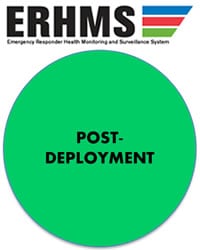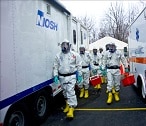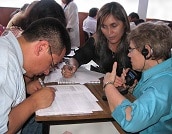Post-Deployment – ERHMS
Post-Deployment Phase

Responder Out-Processing Assessment

The out-processing assessment is the minimum post-deployment evaluation that should be conducted for responders. Out-processing assessments are conducted to determine if responders have been adversely affected by their deployment duties and to what extent. The assessments are also to evaluate trends within the population of workers for the purpose of identifying potential risks to others. Emergency responders may encounter conditions involving complex, uncontrolled environments such as those with hazardous chemicals including multiple or mixed chemical exposures, microbial agents, physical agents (e.g., temperature, noise, etc.), long work shifts, or stressful experiences. Therefore, all responders should receive an out-processing assessment as part of the demobilization process or as soon as possible after demobilization. Out-processing assessment should be simple, concise, and standardized. Ideally, the out-processing assessment would be a face-to-face interview in the field as responders are preparing to go back to their duty station. If face-to-face is not possible, other good options include collecting information by using paper, through the web, by phone interviews, or by conducting the assessment one to two weeks before or after demobilization.
Tools & Resources
Post-Event Tracking of Emergency Responder Health and Function
Post-event tracking of responder health may be appropriate because of potential health and safety risks that are characteristic in emergency response work. The goal is to identify health or functional consequences potentially associated with response work (e.g., exposure, illness, injury, or disability including emotional trauma) and to intervene early to maximize the chances for recovery and to stop further exposure for workers remaining on-scene (i.e., through exposure control or medical treatment).
The decision for further tracking should be based on a variety of factors including information regarding the responder’s exposures, hazardous work activities, concerns expressed by the responder or safety and health personnel, the adequacy of control measures and appropriate adherence, and injuries and illnesses incurred during the deployment. Such information should be viewed in the context of the worker’s prior physical and mental health status and the extent of their prior knowledge and experience with disaster work.
Post-event tracking of health may be difficult or costly to conduct on a case-by-case basis, and it is often more suitable for such decisions to be made for categories of responders with similar exposure histories. High-priority worker groups for post-event health tracking would include those most likely to have exposures to hazardous agents or conditions and those reporting outbreaks of similar adverse health outcomes.
Tools & Resources
- ERHMS Fact Sheet: Post-Event Tracking of Emergency Responder Health and Function
- National Comorbidity Survey – Kessler-6 (K-6 or K-10)
- NIOSH Pocket Guide to Chemical Hazards
- NIOSH Office of Mine Safety and Health Research – Traumatic Incident Stress: Information for Emergency Response Workers
- NIOSH Publication – First Responders: Protect Your Employees with an Exposure Control Plan
- Perceived Stress Scale (PSS)
- Revised Children’s Manifest Anxiety Scale (RCMAS)
- OSHA Screening and Surveillance: A Guide to OSHA Standards
- US National Library of Medicine – Abstract: A Decision Process for Determining Whether to Conduct Responder Health Research Following Large Disasters.
Lessons-learned and After-action Assessments

At the conclusion of an event, there is a need to assess the emergency response through each phase (pre-deployment, deployment, and post-deployment) to identify ways to improve processes and outcomes throughout. Assessments ensure that the best possible practices are used, that mistakes are identified, and measures are taken to prevent issues during the next response. This is often accomplished through a document called an “After Action Report” or a similar name. Documenting deficiencies in communications of safety and health protocols, examining the tasks and timing of exposures, and noting when rostering was ineffective, helps organizers improve the safety of the environment and protects emergency responders during an emergency.
Tools & Resources
- 2013 Homeland Security Exercise and Evaluation Program
- AIHA Online Marketplace Store – Incident Safety and Health Management Handbook (ISHMH)
- APA Abstract: Early Interventions & Risk Assessment Following Disaster. Psychiatric Annals
- DHS Exercise and Evaluation Program (HSEEP) – After Action Report/Improvement Plan
- DHS Post-Deployment Assessment Questionnaire Declination
- ERHMS Emergency Responder Health Monitoring and Surveillance: Implementation Training Worksheet
- ERHMS ICS Form 221 Demobilization Checklist
- ERHMS Post-Event Tracking of Emergency Responder Health and Function
- FEMA Incident Command System Review Materials
- FEMA National Incident Management System (NIMS) Resource Center
- FEMA NIMS Appendix B: Incident Command System
- JOEM Protecting Workers in Large-Scale Emergency Responses: NIOSH Experience in the Deepwater Horizon Response
- NIOSH Publication – First Responders: Protect Your Employees with an Exposure Control Plan
- OSHA Standard:1910.120: Hazardous Waste Operations and Emergency Response (HAZWOPER)
- PLOS Currents Disasters – Review of the OSHA-NIOSH Response to the Deepwater Horizon Oil Spill: Protecting the Health and Safety of Cleanup Workers
